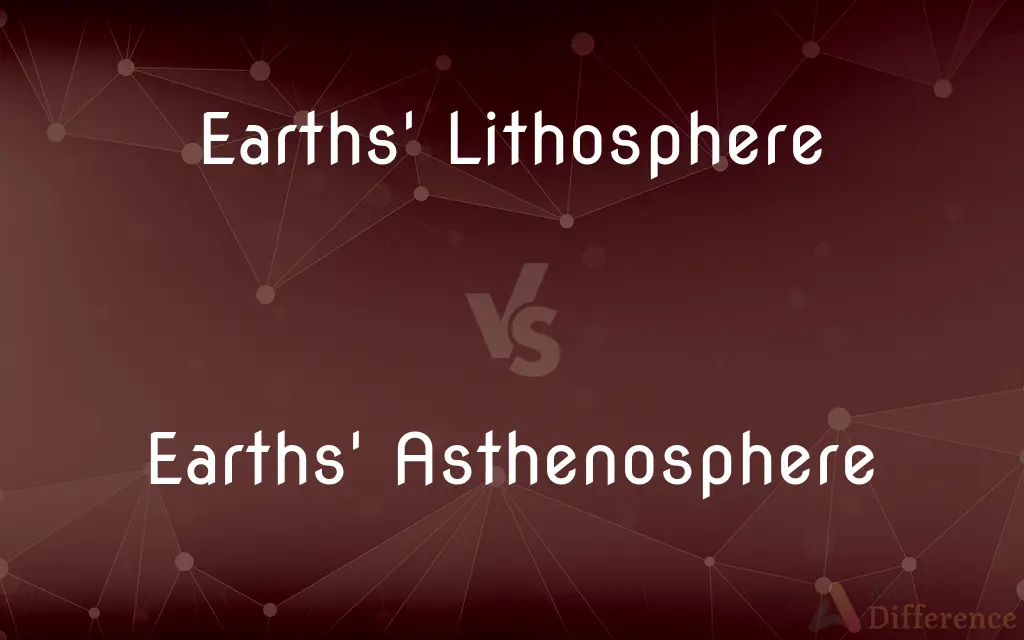Earths' Lithosphere vs. Earths' Asthenosphere — What's the Difference?
By Tayyaba Rehman & Fiza Rafique — Published on March 1, 2024
Earth's lithosphere is the rigid outer layer, including the crust and upper mantle, known for its stability. The asthenosphere is a semi-fluid layer beneath the lithosphere, known by its plasticity and role in facilitating the movement of tectonic plates.

Difference Between Earths' Lithosphere and Earths' Asthenosphere
Table of Contents
ADVERTISEMENT
Key Differences
The Earth is composed of several layers, each distinct in its composition and physical properties. The lithosphere and asthenosphere are two such layers that play critical roles in the planet's geological dynamics.
The lithosphere comprises the Earth's crust and the uppermost part of the mantle, extending to about 100 kilometers below the surface. This layer is rigid and brittle, making it capable of breaking and causing earthquakes. The lithosphere is divided into tectonic plates that float atop the more pliable layer beneath – the asthenosphere. These tectonic plates move due to the convective currents within the asthenosphere, leading to phenomena such as earthquakes, volcanic eruptions, and the formation of mountain ranges.
Beneath the lithosphere lies the asthenosphere, which extends from about 100 kilometers to approximately 700 kilometers below the Earth's surface. Unlike the rigid lithosphere, the asthenosphere is semi-fluid and plastic-like. This viscosity allows the asthenosphere to flow slowly, accommodating and driving the movement of the lithosphere's tectonic plates. The asthenosphere's plasticity is due to the high pressure and temperature conditions it experiences, which partially melt the mantle rock, making it less rigid and more ductile.
The lithosphere's interaction with the asthenosphere is fundamental to plate tectonics. The lithosphere's plates move, collide, and slide past each other on the asthenosphere's plastic flow, shaping the Earth's surface over geological time scales. This dynamic process is responsible for creating the Earth's topographic features, including mountains, valleys, and ocean basins.
The lithosphere provides a solid surface for life and ecosystems, whereas the asthenosphere's movements beneath influence the lithosphere's stability and the occurrence of geological events. Understanding the relationship between these two layers is crucial for geologists to predict seismic activity and understand the Earth's evolving landscape.
ADVERTISEMENT
Comparison Chart
Composition
Crust and upper mantle
Upper mantle
Depth
0-100 kilometers below the surface
100-700 kilometers below the surface
State
Rigid and brittle
Semi-fluid and plastic-like
Role in Plate Tectonics
Comprises tectonic plates
Facilitates the movement of tectonic plates
Physical Properties
Cool and strong
Hot and ductile
Movement
Moves as rigid plates
Flows slowly, allowing plate movement
Contribution to Earth's Features
Directly forms the Earth's surface features
Influences the movement and formation of surface features
Seismic Activity
Location of earthquakes and volcanic activity
Affects the dynamics of plate movements and seismic activity indirectly
Compare with Definitions
Earths' Lithosphere
Location of most seismic activity.
The Ring of Fire is a result of lithospheric plate interactions.
Earths' Asthenosphere
Partially melted, contributing to its viscosity.
Magma originates from the partial melting of the asthenosphere.
Earths' Lithosphere
The Earth's outermost layer, including crust and upper mantle, involved in tectonic activities.
The Himalayas were formed by the collision of two lithospheric plates.
Earths' Asthenosphere
A semi-fluid layer beneath the lithosphere, allowing for plate movement.
Tectonic plates glide over the asthenosphere.
Earths' Lithosphere
Directly forms the Earth's surface features.
Volcanic islands emerge at lithospheric plate boundaries.
Earths' Asthenosphere
Influences the dynamics of lithospheric movements.
The slow flow of the asthenosphere affects the speed of tectonic plate movement.
Earths' Lithosphere
Comprises tectonic plates that float on the asthenosphere.
The Pacific Plate is one of the largest lithospheric plates.
Earths' Asthenosphere
Characterized by its plasticity under high temperature and pressure.
The asthenosphere's ductility facilitates the convection currents driving plate tectonics.
Earths' Lithosphere
Characterized by its rigidity and ability to break.
Earthquakes occur due to the movement of the lithosphere's tectonic plates.
Earths' Asthenosphere
Indirectly contributes to the formation of Earth's surface features.
Mountain building processes are influenced by asthenospheric movements beneath the lithosphere.
Common Curiosities
What defines the boundary between the lithosphere and asthenosphere?
The boundary is defined by a significant decrease in rigidity, where the upper mantle (lithosphere) gives way to the more ductile, semi-fluid asthenosphere.
How do the lithosphere and asthenosphere interact during an earthquake?
Earthquakes primarily occur in the lithosphere when tectonic plates suddenly move or fracture. The asthenosphere's flow can influence these movements by accommodating the shifting plates.
What happens at the lithosphere-asthenosphere boundary during volcanic eruptions?
Volcanic eruptions occur when magma from the asthenosphere rises through fractures in the lithosphere, reaching the surface.
How does the thickness of the lithosphere vary across the Earth?
The thickness of the lithosphere varies, being thinner at oceanic ridges and thicker beneath continents and old oceanic plates.
Can the asthenosphere be directly observed?
Direct observation of the asthenosphere is challenging due to its depth. However, its properties are inferred through seismic studies and the behavior of seismic waves.
Why is the asthenosphere important for plate tectonics?
The asthenosphere's plasticity allows the lithosphere's tectonic plates to move, collide, and subduct, driving the Earth's tectonic activity.
How does the temperature of the asthenosphere compare to that of the lithosphere?
The asthenosphere is hotter than the lithosphere, with temperatures high enough to allow mantle rock to partially melt, making it ductile.
What role does the asthenosphere play in continental drift?
The asthenosphere facilitates continental drift by allowing the Earth's plates, including continental plates, to move over its semi-fluid layer.
How do scientists study the asthenosphere?
Scientists study the asthenosphere using seismology, magnetotellurics, and laboratory experiments simulating its high-pressure, high-temperature conditions.
Are there any other layers of the Earth beneath the asthenosphere?
Yes, beneath the asthenosphere lies the lower mantle, followed by the Earth's outer and inner cores, each with distinct properties and compositions.
Share Your Discovery

Previous Comparison
Pledged vs. Donated
Next Comparison
Pushchair vs. StrollerAuthor Spotlight
Written by
Tayyaba RehmanTayyaba Rehman is a distinguished writer, currently serving as a primary contributor to askdifference.com. As a researcher in semantics and etymology, Tayyaba's passion for the complexity of languages and their distinctions has found a perfect home on the platform. Tayyaba delves into the intricacies of language, distinguishing between commonly confused words and phrases, thereby providing clarity for readers worldwide.
Co-written by
Fiza RafiqueFiza Rafique is a skilled content writer at AskDifference.com, where she meticulously refines and enhances written pieces. Drawing from her vast editorial expertise, Fiza ensures clarity, accuracy, and precision in every article. Passionate about language, she continually seeks to elevate the quality of content for readers worldwide.
















































